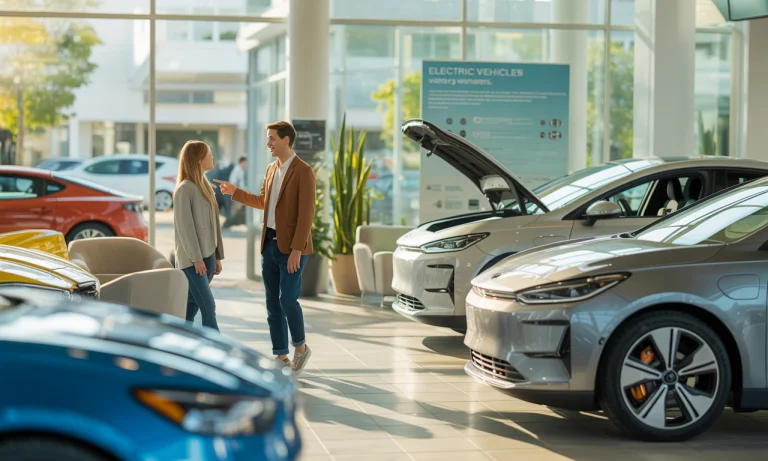On busy city streets and quiet suburban boulevards, the hum of electric vehicles is now part of the everyday soundtrack. Buyers who once measured a car’s worth in horsepower and miles per gallon now weigh battery range, charging speed, and connected tech. The surge in options—Tesla, Nissan, Hyundai, BMW, Kia, Ford, Volkswagen, Audi, Polestar, and Chevrolet all racing into the electric future—means choice has never been richer, or more complex. More than a matter of sustainability or savings, picking your first EV is about finding the model that lives up to your aspirations and matches your daily rhythm. As incentives boost affordability and chargers sprout across neighborhoods, the story isn’t just which electric car, but how it fits the contours of your life. For first-timers navigating this evolving landscape, the right guidance can turn uncertainty into anticipation, and help ensure that first charge feels like a gateway to something transformative.
Choosing Your First Electric Car: Understanding Real Needs and Lifestyles
Every electric journey begins with self-reflection. Tomas, a young professional in Chicago, discovered that his daily commute—short, repetitive, mostly within city bounds—meant a compact Chevrolet or Nissan was all he needed for 95% of his trips. He rarely took road trips, so range anxiety faded into the background. In contrast, his friend Maya, whose extended family often escaped to lakes three hours away, leaned toward models like the Hyundai IONIQ or Tesla Model Y, blending range with space and reliability. Their experiences highlight a truth confirmed by industry experts: EV selection must fit lifestyle, not just fantasy.
According to recent insights, comfort for all potential drivers—including accommodating the elderly or providing enough cargo room for groceries—often trumps raw specs. And for those using their vehicle for work, like rideshare drivers, features reducing fatigue and maximizing storage are key, as discussed here. Safety, particularly in cities with unpredictable weather, should never take a backseat. Above all, the EV you choose should turn routine drives into moments of delight, setting the stage for the next great chapter in personal mobility.
| Lifestyle | Suggested EV Type | Key Priorities |
|---|---|---|
| Urban commuting | Chevrolet Bolt EV, Nissan Leaf, Hyundai Kona Electric | Ease of parking, efficiency, cost |
| Family travel | Tesla Model Y, Ford Mustang Mach-E, Volkswagen ID.4 | Range, cargo space, rear seating |
| Ridesharing/Work | Kia Niro EV, Polestar 2 | Comfort, capacity, low operating costs |
| Performance | Tesla Model 3, Audi e-tron | Acceleration, tech features, prestige |
Evaluating Electric Car Range and Charging Needs
Anna, accustomed to long weekends away, understood that real-world range made all the difference. She pored over figures for models like the Tesla Model S, Lucid Air, and Mercedes EQS, comparing their advertised range with the reality of her journeys. What emerged was clear: charging infrastructure and speed are inseparable from the range debate. The anxiety of running low on battery isn’t just about numbers—it’s about access, convenience, and confidence on the open road.
Public charging networks have expanded rapidly, with federal grants propelling new stations into small towns and big cities. For home charging, she found resources explaining the difference between level 1, level 2, and DC fast charging, and how to plan installation for maximum convenience (detailed comparison here). The question shifted from “Will I make it?” to “How fast can I be ready to go again?” Charging speed, battery reliability, and network compatibility have become the new benchmarks, shaping which vehicles are truly road-trip ready.
| Model | Max. Range (mi) | Charging Time (to 80%) | Best Use Case |
|---|---|---|---|
| Tesla Model 3 Long Range | 358 | ~30 min (DC fast) | Cross-country trips |
| Chevrolet Bolt EV | 259 | ~1 hr (Level 2) | City & suburb commuting |
| Hyundai IONIQ 5 | 303 | ~18 min (Ultra-fast) | Families, tech-lovers |
| Polestar 2 | 270 | ~35 min (DC fast) | Mixed urban-country use |
Electric Vehicle Affordability and Incentives: Making the Switch Work Financially
For Mark and Sima, the tipping point toward going electric was realizing how federal and state incentives could shrink upfront costs. Incentives like those highlighted in the Inflation Reduction Act and explained here can change the math dramatically, especially when paired with lower running costs. It’s worth remembering that eligibility hinges on battery sourcing and assembly—details that vary by year and brand.
In 2025, choices abound on both ends of the price spectrum. While high-end luxury from Audi or BMW appeals to some, practical picks such as the Nissan Leaf or Volkswagen ID.4 offer robust technology at accessible prices. Maintenance costs, often a silent burden in gasoline cars, drop with EVs—no oil changes, fewer moving parts, and software-enabled updates that eliminate many workshops visits (maintenance savings demystified). Savvy buyers compare total cost of ownership over five years, not just sticker prices. For many, the future feels more affordable than it looks at first glance.
| Model | Base Price (USD) | Tax Credit Eligible? | Estimated 5-Year Savings vs Gas Car |
|---|---|---|---|
| Chevrolet Bolt EV | $25,600 | Yes | $6,000 |
| Nissan Leaf | $28,040 | Yes | $5,200 |
| Volkswagen ID.4 | $37,495 | Yes | $4,900 |
| Tesla Model 3 | $39,990 | Some trims | $7,300 |
Innovative Features and Technology—More Than Just Electric
The spark that sets modern EVs apart isn’t just their batteries but their digital brains. When Lisa test-drove the BMW i4, she marveled at how its driver-assistance features anticipated her every move. Others, drawn to Audi or Ford models, found that integrated infotainment systems and app-controlled climate scheduling made each trip more personal. For the ultra-connected crowd, Volkswagen and Polestar showcase seamless over-the-air updates, keeping vehicles at the technological edge. These advancements—detailed in pieces like this deep dive on car technology leaps—turn ordinary commutes into immersive experiences.
Software defines the character of an EV, from adaptive cruise to AI-powered diagnostics. The rise of autonomous driving features, as previewed in the latest industry analyses, hints at a time when safety, efficiency, and entertainment will blend seamlessly. But for first-time buyers in 2025, it’s about more than gizmos—it’s about driving something that feels like tomorrow, every time you sit behind the wheel.
| Feature | Benefit | Brands Leading the Way |
|---|---|---|
| Adaptive cruise & driver assist | Reduces fatigue, enhances highway safety | Tesla, BMW, Polestar |
| Over-the-air updates | Improves features & security without dealership visits | Volkswagen, Hyundai, Audi |
| Remote diagnostics | Prevents breakdowns, simplifies service | Ford, Kia, Tesla |
| Ultra-fast charging compatibility | Minimizes stop times on long trips | Hyundai, BMW, Polestar |
Maintenance, Resale, and the Road Ahead: Planning Your EV Ownership Journey
As the crew at LeftLane News notes here, thinking beyond the first few years can protect your investment. Electric cars from brands like Tesla or Kia are already showing slower depreciation than expected, especially when battery warranty and software updates keep them fresh. Regular digital checkups have replaced the grease and grime of old-school discipline. Those who plan ahead—like Jill, who schedules annual battery reports and keeps her charging routine consistent—are rewarded by strong resale value and fewer headaches.
Additionally, trends in 2025 show a robust market for pre-owned EVs, buoyed by consumer confidence in reliability gains. With more models offering extended warranties and transparent maintenance histories, EVs are shedding the perception of being risky or experimental. For those considering long-haul adventures, resources like road trip prep guides make stretching those electrons easy. As charging technology leaps forward, the only question left may be: how far can you dream?
| Ownership Factor | Typical Gas Car | Typical EV |
|---|---|---|
| Annual maintenance cost | $900 | $450 |
| Resale value after 5 yrs | ~55% | ~65% |
| Average downtime / year | 5 days | 2 days |
Frequently Asked Questions About Choosing Your First Electric Vehicle
-
How do I determine what range I actually need?
Think realistically about your routine—add up weekly driving distances and consider occasional long trips. Choose a car that covers 120-150% of your average daily use, and check available charging in your area. More guidance appears in this practical range guide. -
Are home chargers easy to install?
Most modern homes support Level 2 chargers, which an electrician can install for faster refueling. If you rent, talk to your landlord or property manager about potential upgrades, as detailed here. -
Will my EV require special maintenance?
Electric vehicles generally need less maintenance than gas models—no oil changes, fewer parts to break—though battery health and software updates matter. Resources like this guide break down ongoing care. -
What are the key differences between major brands like Tesla, Kia, or Volkswagen?
Tesla leads with software and range; Kia is celebrated for value and comfort; Volkswagen blends design and practicality. Each offers unique tech and support features, as reviewed in this brand comparison. -
How do I avoid common pitfalls as a first-time EV buyer?
Don’t underestimate your charging needs, ignore incentives, or skip test drives. Findings in this buyer’s mistakes guide help make each decision count.
Did you like it? 4.7/5 (27)







